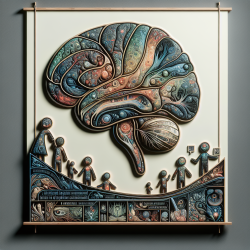Introduction
As a speech-language pathologist, understanding the intricate relationship between early brain development and language outcomes is crucial. Recent research published in NeuroImage: Clinical, titled "Early changes in brain structure correlate with language outcomes in children with neonatal encephalopathy," offers valuable insights into how early brain imaging can predict language development in children. This blog post will delve into the key findings of this study and explore how practitioners can leverage these insights to enhance their practice.
Understanding the Research
The study examined 32 children with neonatal encephalopathy (NE), focusing on how early changes in brain structure, as observed through MRI at six months, correlate with language outcomes at 30 months. The researchers employed deformation-based morphometry (DBM) to assess variations in brain volume and their association with language scores on the Bayley Scales of Infant and Toddler Development (Bayley-III).
Key findings include:
- Regional brain volume, particularly in the perisylvian cortical regions, correlates significantly with language scores.
- Changes in regional brain volume were not correlated with motor or cognitive outcomes.
- Quantitative measures of brain volume on early MRI can help identify infants at risk for poor language outcomes.
Implications for Practitioners
For practitioners in speech-language pathology, these findings underscore the importance of early identification and intervention. Here are some ways practitioners can apply these insights:
- Early Screening: Incorporate early MRI findings into screening processes to identify children at risk for language delays. This can lead to timely interventions and better outcomes.
- Collaborative Care: Work closely with pediatric neurologists and radiologists to interpret MRI results and integrate them into comprehensive care plans.
- Targeted Interventions: Develop intervention strategies that focus on enhancing language skills in children identified as at risk, potentially mitigating the impact of early brain structure changes.
Encouraging Further Research
While this study provides significant insights, it also opens the door for further research. Practitioners are encouraged to explore the following areas:
- Investigate the potential of using other imaging techniques to predict language outcomes.
- Examine the long-term impact of early interventions on children identified through early MRI screening.
- Explore the role of environmental factors and their interaction with early brain structure changes in influencing language development.
Conclusion
The study on early changes in brain structure and language outcomes offers a promising avenue for improving language development in children with neonatal encephalopathy. By integrating these findings into practice, speech-language pathologists can enhance their ability to predict and address language delays, ultimately leading to better outcomes for children.
To read the original research paper, please follow this link: Early changes in brain structure correlate with language outcomes in children with neonatal encephalopathy.










